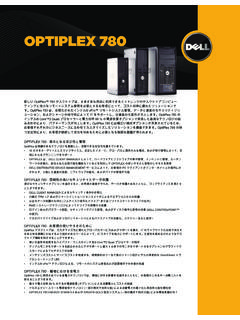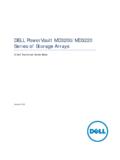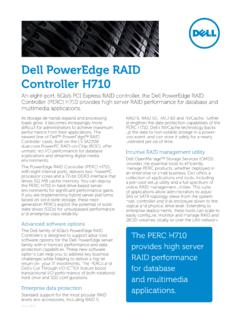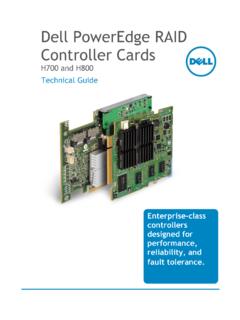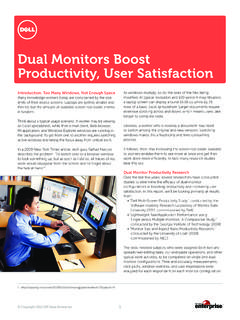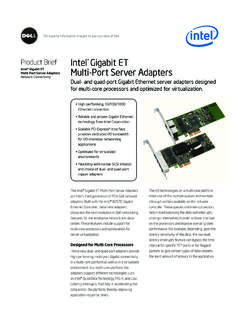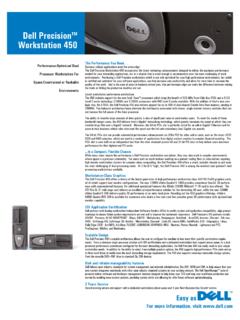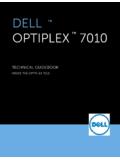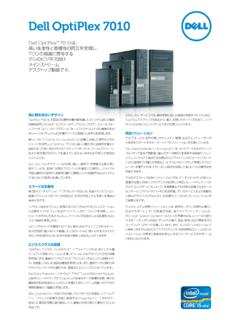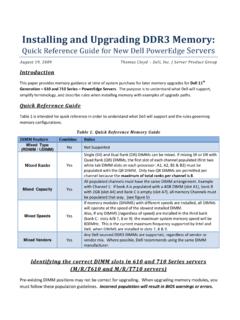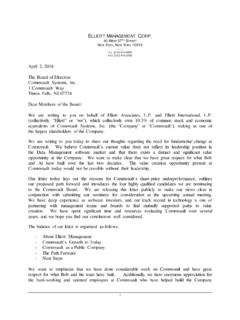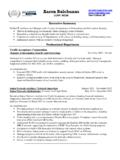Transcription of TECHNICAL GUIDEBOOK - Dell
1 dell PowerEdge T310 TECHNICAL Guide 0 DELLTM POWEREDGE T310 TECHNICAL GUIDEBOOK dell PowerEdge T310 TECHNICAL Guide 1 White Paper s Title By (Author s name) This document is for informational purposes only. dell reserves the right to make changes without further notice to any products herein. The content provided is as is and without express or implied warranties of any kind. dell , PowerEdge, and ReadyRails are trademarks of dell , Inc. Citrix and XenServer are trademarks of Citrix Systems, Inc. and/or one or more of its subsidiaries, and may be registered in the United States Patent and Trademark Office and in other countries. Intel , Xeon , Pentium , and Celeron are registered trademark of Intel Corporation in the and other countries. HP and COMPAQ are trademarks of Hewlett-Packard Company. Broadcom is a registered trademark and NetXtreme is a trademark of Broadcom Corporation and/or its affiliates in the United States, certain other countries and/or the EU.
2 CommVault Galaxy or Simpana are registered trademarks of CommVault Systems, Inc. InfiniBand is a registered trademark and service mark of the InfiniBand Trade Association. Matrox is a registered trademark of Matrox Electronic Systems Ltd. Microsoft and SQL Server are either registered trademarks or trademarks of Microsoft Corporation in the United States and/or other countries. Mellanox is a registered trademark of Mellanox Technologies, Inc. and ConnectX, InfiniBlast, InfiniBridge, InfiniHost, InfiniRISC, InfiniScale, and InfiniPCI are trademarks of Mellanox Technologies, Inc. Red Hat is a registered trademark of Red Hat, Inc. in the United States and other countries. Linux is a registered trademark of Linus Torvalds. Symantec and Backup Exec are trademarks owned by Symantec Corporation or its affiliates in the and other countries. Novell and Suse are registered trademarks of Novell, Inc. Nuvoton is a registered trademark of Nuvoton Technology Corporation.
3 QLogic and PathScale are registered trademarks of Qlogic Corporation. VMware is a registered trademark and vSphere is a trademark of VMware, Inc. in the United States and/or other jurisdictions. Other trademarks and trade names may be used in this document to refer to either the entities claiming the marks and names or their products. dell disclaims proprietary interest in the marks and names of others. Copyright 2010 dell Inc. All rights reserved. Reproduction or translation of any part of this work beyond that permitted by copyright laws without the written permission of dell Inc. is unlawful and strictly forbidden. Initial Release February 2010 dell PowerEdge T310 TECHNICAL Guide 2 Table of Contents 1 Overview .. 6 Product Description .. 6 Product Comparison .. 7 2 New Technologies .. 10 Overview .. 10 Detailed Information .. 10 Platform Features .. 10 Processors .. 10 Software RAID .. 11 Hardware RAID .. 11 3 Systems Overview.
4 12 4 Mechanical .. 14 Chassis Description .. 14 Dimensions and Weight .. 14 Front Panel View and Features .. 15 Back Panel View and Features .. 16 Power Supply Indicators .. 17 NIC Indicators .. 17 Side View .. 19 Internal Chassis Views .. 19 Fan .. 20 Control Panel/LCD .. 21 Security .. 22 Cover Latch .. 22 Bezel .. 23 Hard Drive Access .. 23 Trusted Platform Module (TPM) .. 24 Power Switch Security .. 24 Intrusion Alert .. 24 Secure Mode .. 24 USB Key .. 24 Battery .. 25 Field Replaceable Units (FRU) .. 26 User Accessible Jumpers, Sockets, and Connectors .. 26 5 Power, Thermal, Acoustic .. 27 Power Supplies .. 27 Thermal .. 27 Acoustics .. 29 Other Environmental Requirements .. 31 Maximum Vibration .. 31 Maximum Shock .. 31 Airborne Contaminant Level .. 31 dell PowerEdge T310 TECHNICAL Guide 3 Maximum Input Amps .. 31 Energy Star Compliance .. 31 6 Processors .. 32 7 Memory .. 33 Overview.
5 33 DIMMs Supported .. 33 Slots/Risers .. 35 Speed .. 36 Sparing .. 38 Mirroring .. 38 RAID .. 38 Supported Configurations .. 38 8 Chipset .. 40 Overview .. 40 Direct Media Interface (DMI) .. 40 PCI Express Interface .. 40 SATA Interface .. 40 Advanced Host Controller Interface (AHCI) .. 40 Intel Rapid Storage Technology .. 40 PCI Interface .. 41 Low Pin Count (LPC) Interface .. 41 Serial Peripheral Interface (SPI) .. 41 Compatibility Module (DMA Controller, Timer/Counters, Interrupt Controller) .. 41 Advanced Programmable Interrupt Controller (APIC) .. 41 Universal Serial Bus (USB) Controllers .. 42 Real-Time Clock (RTC) .. 42 General Purpose Inputs and Outputs (GPIO) .. 42 Enhanced Power Management .. 42 Chipset Management .. 42 System Management Bus (SMBus ) .. 43 Intel Anti-Theft Technology .. 43 Intel Virtualization Technology for Directed I/O .. 43 JTAG Boundary-Scan .. 43 9 BIOS .. 44 Overview.
6 44 Supported ACPI States .. 44 Power Management .. 45 10 I/O Slots .. 47 Overview .. 47 External Controller Cards .. 49 PCI Card Dimensions .. 49 11 Storage .. 50 Overview .. 50 Drives .. 50 RAID Configurations .. 51 Back-Up Drives (Tape) .. 53 12 Video .. 53 13 Rack Information .. 55 14 Operating Systems .. 56 15 Virtualization .. 58 dell PowerEdge T310 TECHNICAL Guide 4 16 Systems Management .. 59 Overview .. 59 Server Management .. 59 Embedded Server Management .. 60 Lifecycle Controller and Unified Server Configurator .. 60 iDRAC6 Express .. 61 iDRAC6 Enterprise .. 61 17 Peripherals .. 63 USB Peripherals .. 63 External Storage .. 63 18 Packaging Options .. 64 Tables Table 1. Comparison for PowerEdge Servers .. 7 Table 2. Product Features Summary .. 12 Table 3. Dimensions and Weight .. 14 Table 4. NIC LED Activity .. 18 Table 5. Environmental Specifications and Operating Requirements .. 28 Table 6. Acoustical Specifications.
7 30 Table 7. Supported Processors .. 32 Table 8. Memory Support: U-DIMM .. 34 Table 9. Memory Support: R-DIMM .. 35 Table 10. 4 DIMM Information .. 36 Table 11. 4 DIMM MAX Memory and DRAM Technology .. 36 Table 12. 6 RDIMM (Registered DDR3 ECC) Xeon only .. 37 Table 13. 6 DIMM MAX Memory and DRAM Technology .. 37 Table 14. Supported Memory Configurations .. 38 Table 15. ACPI Wake Up Events and States .. 44 Table 16. Power Management Features .. 45 Table 17. Current Power Profiles that 11G BIOS will Expose in BIOS Setup .. 46 Table 18. PCIe Slot Specification .. 47 Table 19. Quantities and Priorities .. 48 Table 20. External Controller Cards .. 49 Table 21. PCI Card Dimensions .. 49 Table 22. PowerEdge T310 Drives .. 50 Table 23. Raid Configurations .. 51 Table 24. OS Editions Not Supported by PERC S100 and S300 .. 52 Table 25. Microsoft OS Support .. 56 Table 26. Linux OS Support .. 57 Table 27. Supported Virtualization OS .. 58 Table 28.
8 Unified Server Configurator Features and Description .. 60 Table 29. Features List for BMC, iDRAC6, and vFlash .. 61 Table 30. Dimensions and Weight .. 64 Table 31. PowerEdge T310 Volatility .. 66 Table 32. Volatility: Data Writing and Purpose .. 68 Table 33. Methodology for Data Input to Memory .. 69 Table 34. Methodology for Memory Protection and Clearing .. 71 dell PowerEdge T310 TECHNICAL Guide 5 Figures Figure 1. PowerEdge T310 Dimensions 14 Figure 2. Front Panel Views and Features 15 Figure 3. Back Panel View and Features 16 Figure 4. Power Supply Indicators for Redundant PSU Only 17 Figure 5. NIC Indicators 17 Figure 6. Side View 19 Figure 7. Hot-Swap HDD Chassis 19 Figure 8. Cabled HDD Chassis 20 Figure 9. Rear and Internal Views of Fan 20 Figure 10. LCD-Front Panel (Hot-Swap HDD Configuration) 21 Figure 11. LED Front Panel (Cabled HDD Configuration) 21 Figure 12. System Coin Lock under Cover Latch 22 Figure 13. Bezel Lock in Front Bezel 22 Figure 14.
9 Lock Port on Back of Chassis 23 Figure 15. Bezel and Key Storage 23 Figure 16. Intrusion Switch 24 Figure 17. Internal USB Connectors 25 Figure 18. Motherboard Battery (CR2032) 25 Figure 19. Battery Holder for PERC Card: Located Under the HDD Cage 26 Figure 20. Slots and Risers 36 Figure 21. Packaging Diagram 64 dell PowerEdge T310 TECHNICAL Guide 6 1 Overview Product Description dell s robust and reliable, 1-socket PowerEdge T310 tower server offers the performance of Intel processors, DDR3 memory, advanced systems management options and the availability of up to four hard drives ( or ) in a compact tower chassis. The dell PowerEdge T310 server delivers enterprise-level performance, redundancy, and comprehensive right-sized manageability options in a 1-socket tower that is simple to own, deploy, and manage. The dell PowerEdge T310 was designed to meet the needs of the growing small business or remote office by offering more features and performance than a basic, entry-level server.
10 Customizable with optional advanced systems management capabilities including remote management, a short inch chassis, redundancy features and cost-effective RAID options, the T310 is the ideal robust and reliable 1-socket tower server. dell aims to add value to your business by providing the features you need. Our goal is to deliver value through tailored solutions based on industry standards, as well as purposeful, innovative design. The PowerEdge T310, part of the 11th Generation PowerEdge server portfolio, is built with system design commonality and reliability. All 11th Generation servers are built with user ease in mind. All external ports, power supplies, LED lights, and LCD screens are kept in the same location for familiar user experience and easy installation and deployment. Robust, metal hard drive carriers and organized cabling are designed to improve component access and airflow across the server. The PowerEdge T310 s purposeful design provides quiet acoustics and an optional interactive LCD screen positioned on the front by the bezel for ease of monitoring.
